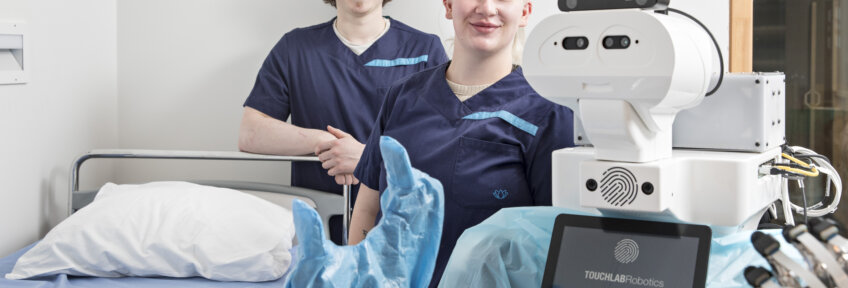Laakso Hospital trialled the state-of-the-art care robot Välkky, which utilises NASA space technology. The results were promising so the robot will get more trials and the technologies will be developed further. The hospital staff and patients were really interested in the robot and its versatile possibilities.
Innovation Summary
Innovation Overview
Laakso Hospital trialled the state-of-the-art care robot Välkky, which utilises NASA space technology. The aim was to test what the remote-controlled robot can be used for in a hospital environment and how it can support the work of nurses. Välkky has the advantage that it is controlled by healthcare professionals, so it is safe for patients even during the trial period. The robot was commended by nurses and patients alike.
The trial started in spring 2023 and was extended until the end of 2023. The Välkky trial in the summer was carried out as part of the FinEst Twins project. Additional funding for the continuation of the trial was secured from the City of Helsinki Economic Development Department and digital funding managed by Forum Virium Helsinki. Top robotics experts are currently setting up a new project around Välkky. Laakso Hospital is also included in the new plans.
In addition to Välkky, the team is also busy testing other technologies designed for health and social services, such as a weighing toilet seat, remote rehabilitation via television, and a map application to help employees during orientations. Together with the City of Helsinki’s health and social services, we prepared a pilot in which sensors help predict the risk of falls and the deterioration of the physical fitness of people in home care.
Innovation Description
What Makes Your Project Innovative?
Using Välkky is exceptionally safe and thus it can be piloted and used in hospital environments relatively easily. Välkky’s movements are constantly controlled by a nurse, so the robot never works without the supervision of a professional. Nurses control the robot via haptic gloves, a haptic suit or a control chair. ‘Haptic’ means technology that utilises the sense of touch. The nurse controlling Välkky and the patient being treated do not have to be in the same room which means the robot can keep the staff safe as well.
What is the current status of your innovation?
The first pilots have ended but City of Helsinki's healthcare municipalities are aiming to find more funding for piloting the robot.
Innovation Development
Collaborations & Partnerships
Laakso Hospital, the City of Helsinki's health and social services and the tech company Touchlab were the most central partners. The funding fro testing came from REDI SOTE project and FinEst Twins project. Additional funding for the continuation of the trial was secured from the City of Helsinki Economic Development Department and digital funding managed by Forum Virium Helsinki.
Users, Stakeholders & Beneficiaries
The Laakso hospital patients and nurses were the ones targeted in the pilot and they would be the first ones to benefit from the robot. After that, there would be also other hospitals, patients, and care takers finding the robot useful.
Innovation Reflections
Results, Outcomes & Impacts
The nurse controlling Välkky and the patient being treated do not have to be in the same room. However, thanks to the robot’s electronic skin, developed originally for the National Aeronautics and Space Administration (NASA), the nurse and the patient still feel each other’s touch.
For the most part, patients had a very positive reaction to the robot. They were willing to be in contact with it.
The most important thing in this trial was to familiarise both the staff and the patients with the robot.
We piloted versatile ways in which the robot could be used so there were pilot runs with nurses and health care staff and real patients. Their opinions were surveyed.
Challenges and Failures
During the summer, 12 nurses were trained to control Välkky. Because the results were promising but the hospital wanted more of them, the trial was continued at least until the end of 2023. So the pool of participants is still relatively small. Due to tehcnical issues the tests have been slower than expected.
Conditions for Success
Health care professionals willing to work with a robot is essential for Välkky as well as patients accepting it. The technical requirements need to be met as well.
Replication
It hasn't yet been replicated but there has been a lot of interest to do so.
Lessons Learned
Välkky was designed to serve as a working partner for care staff. In the future, it could help at least with repetitive tasks and physically taxing work. However, the aim is not to replace nurses, but to make their work easier and maintain their ability to work.
For example, robots could help with heavy lifting work, provide an extra pair of eyes or work in infection rooms, where they could check the patients’ condition without risking a nurse’s wellbeing.
Supporting Videos
https://forumvirium.fi/en/the-worlds-most-advanced-care-robot-received-a-promising-welcome/
Status:
- Identifying or Discovering Problems or Opportunities - learning where and how an innovative response is needed
- Implementation - making the innovation happen
- Evaluation - understanding whether the innovative initiative has delivered what was needed
Date Published:
2 July 2024


